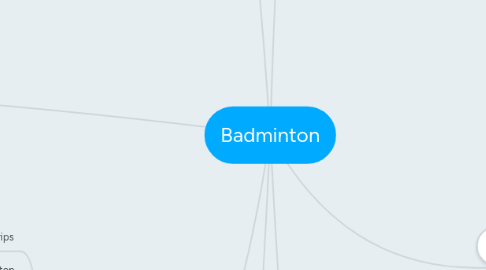
1. Safety
1.1. Proper stretches
1.2. Proper badminton court
1.3. legal badminton rackets and shuttlecocks
1.4. All official badminton rules should be followed
1.5. Proper clothing
1.6. Proper technique
1.7. Warm up games
2. Rules
2.1. Played Indoors between two or four people
2.2. Rally start
2.2.1. A rally starts with a serve
2.3. Rally end
2.3.1. the shuttle touches the ground or gets caught by the net
2.3.2. someone commits a fault
2.4. You need 21 rallies to win the game
2.5. Service Boundaries:
2.5.1. Serve to the opposite left side of your court
2.5.2. if your serve lands on the court within the specified area, you get a point
2.5.3. After the receiver retrieves the serve, the whole opposite side of the court becomes the boundaries
2.5.3.1. If the shuttlecock lands anywhere inside or on the lines, you get a point
2.5.4. When serving, stand within the service box
2.5.4.1. When receiving, stand within the receiving box
2.5.5. Standing on the lines of the service/receiver's box while serving/receiving is a fault. Any part of your feet should not be on top of those lines
2.6. Faults
2.6.1. Contact fault
2.6.2. Over the new fault
2.6.3. Service fault
2.6.4. Receiver fault
2.6.5. Doubles fault
3. Skills
3.1. Forehand & Backhand grips
3.2. Footwork in badminton
3.3. Badminton stance
3.4. Warm ups
3.5. Long foot steps
3.6. Jumping skills
3.7. On the court skills
3.7.1. Proper footwork placements
3.8. Badminton tactics (for singles & doubles)
3.8.1. Attacking tactics
3.8.2. Defending tactics
3.9. Advanced skills
3.9.1. Advanced attacking clear
3.9.2. Advanced defensive clear
3.9.3. Advanced badminton net shot
3.10. Badminton training activities
3.10.1. Strength training
3.10.2. Speed and agility training
3.10.3. Flexibility
4. Grip
4.1. Forehand grip
4.2. Backhand grip
4.3. Bevel grip
4.4. Panhandle grip
5. Etiquette
5.1. Never mock the weaker
5.2. Don't disturb the players on the court
5.3. Don't cheat
5.4. Never play with your mouthful
5.5. Use the proper equipment
5.6. Shake hands with your opponent
5.7. Provide shuttlecocks
5.8. Judge line calls fairly
5.9. Pass the shuttlecock to your opponent
5.10. Don't serve before your opponents are ready
5.11. Don't distract your opponent during a rally
5.12. Don't constantly teach others how to play
6. Fitness
6.1. Speed
6.1.1. Movements around the badminton court are of very short distance, so movement speed training should focus of reaction time, acceleration and agility (change of direction). There are drills to increase foot speed, such as quick feet ladder drills. Training should also focus on strength and power development.
6.2. Strength
6.2.1. Resistance training exercises should focus on those areas which are actively involved in playing badminton, such as the wrist, elbows, shoulders, neck, chest, abdomen, back, thighs, knees and ankles.
6.3. Flexibility
6.3.1. The badminton player uses their flexibility to reach, dive and turn to cover all parts of the court. Flexibility is something that can be improved with regular stretching. The badminton player should stretch before each activity (training and competition), plus other stretches, such as pnf and active stretches, to increase the flexibility of specific muscle groups.
6.4. Endurance
6.4.1. Endurance is a very important component of fitness for badminton. Badminton players cover a lot of ground during a match with little rest. Not only is aerobic fitness important for court play, but you need to be fit for long technical training sessions and to recover well between games during extended tournament play.
